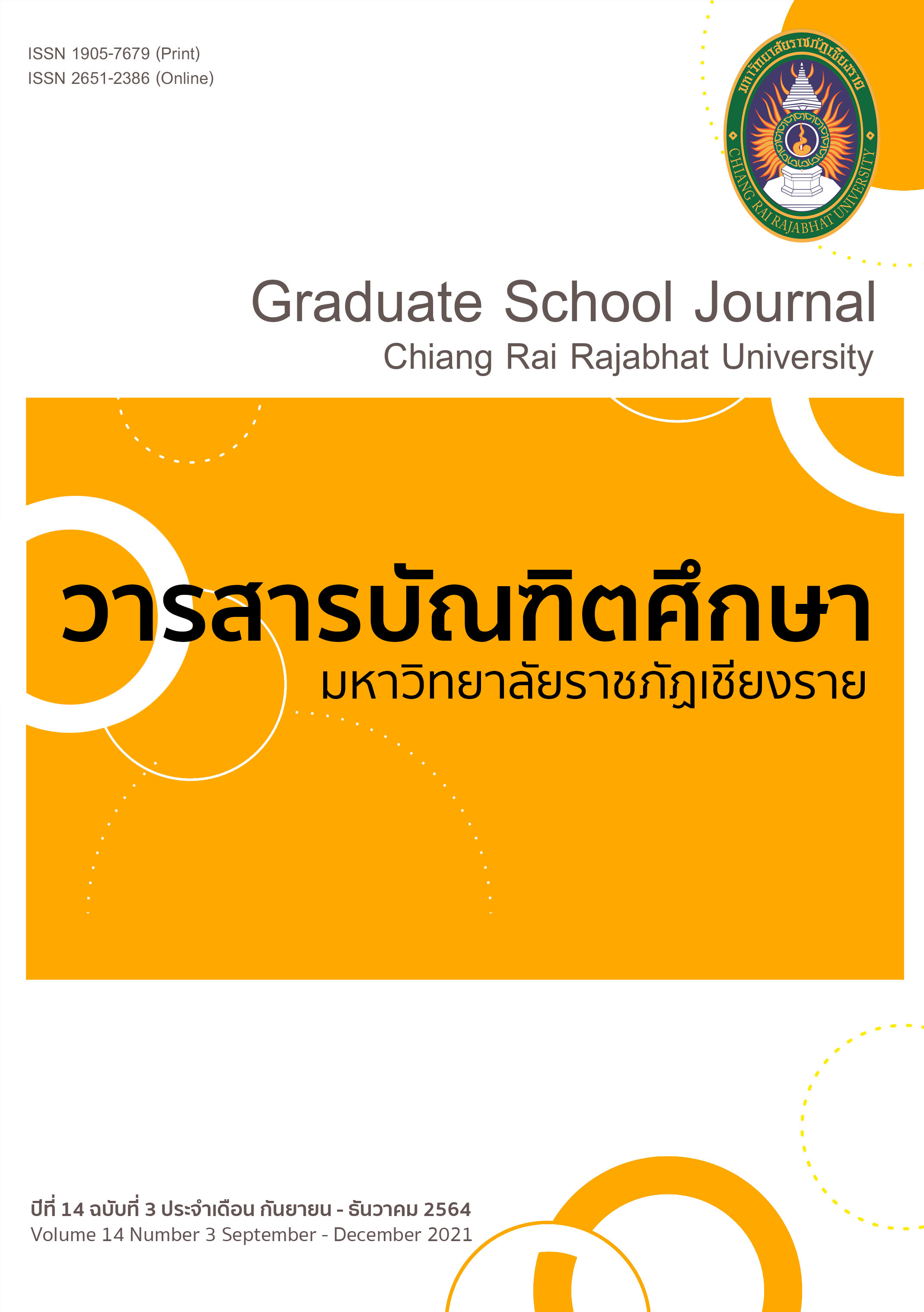ผลของการจัดกิจกรรมการเรียนรู้แบบอุปนัยร่วมกับคำถามระดับสูงที่มีต่อมโนทัศน์ และความสามารถในการให้เหตุผลทางคณิตศาสตร์ เรื่อง เส้นขนาน ของนักเรียนชั้นมัธยมศึกษาปีที่ 2
Main Article Content
บทคัดย่อ
การวิจัยนี้มีวัตถุประสงค์เพื่อเปรียบเทียบมโนทัศน์และความสามารถในการให้เหตุผลทางคณิตศาสตร์ เรื่อง เส้นขนาน ของนักเรียนชั้นมัธยมศึกษาที่ 2 หลังได้รับการจัดกิจกรรมการเรียนรู้แบบอุปนัยร่วมกับคำถามระดับสูง กับเกณฑ์ร้อยละ 70 ซึ่งเป็นแผนการวิจัยแบบศึกษากลุ่มเดียว วัดหลังการทดลองครั้งเดียว โดยกลุ่มตัวอย่างที่ใช้ในการวิจัยครั้งนี้ ได้แก่ นักเรียนชั้นมัธยมศึกษาปีที่ 2 ภาคเรียนที่ 2 ปีการศึกษา 2563 โรงเรียนบ้านมาบกรูด จังหวัดชลบุรี จำนวน 24 คน ซึ่งได้มาจากการสุ่มตัวอย่างแบบกลุ่ม ใช้เวลาในการดำเนินการ วิจัยจำนวน 15 ชั่วโมง โดยดำเนินการสอน 13 ชั่วโมง และเป็นการทดสอบ 2 ชั่วโมง เครื่องมือที่ใช้ในการวิจัย คือ แผนการจัดกิจกรรมการเรียนรู้แบบอุปนัยร่วมกับคำถามระดับสูง จำนวน 9 แผน แบบทดสอบวัดมโนทัศน์ทางคณิตศาสตร์ที่มีค่าความเชื่อมั่น เท่ากับ 0.77 และแบบทดสอบวัดความสามารถในการให้เหตุผลทางคณิตศาสตร์ เรื่อง เส้นขนาน ที่มีค่าความเชื่อมั่น เท่ากับ 0.79 สถิติที่ใช้ในการวิเคราะห์ข้อมูล ได้แก่ ค่าเฉลี่ยเลขคณิต ส่วนเบี่ยงเบนมาตรฐาน และการทดสอบทีสำหรับกลุ่มตัวอย่างเดียว ซึ่งผลการวิจัยสรุปได้ ดังนี้
1. มโนทัศน์ทางคณิตศาสตร์ เรื่อง เส้นขนาน ของนักเรียนชั้นมัธยมศึกษาปีที่ 2 หลังได้รับการจัดกิจกรรมการเรียนรู้แบบอุปนัยร่วมกับคำถามระดับสูง สูงกว่าเกณฑ์ร้อยละ 70 อย่างมีนัยสำคัญทางสถิติ ที่ระดับ .05
2. ความสามารถในการให้เหตุผลทางคณิตศาสตร์ เรื่อง เส้นขนาน ของนักเรียนชั้นมัธยมศึกษาปีที่ 2 หลังได้รับการจัดกิจกรรมการเรียนรู้แบบอุปนัยร่วมกับคำถามระดับสูง สูงกว่าเกณฑ์ร้อยละ 70 อย่างมีนัยสำคัญทางสถิติที่ระดับ .05
Article Details
บทความที่ได้รับการตีพิมพ์เป็นลิขสิทธิ์ของวารสารมหาวิทยาลัยราชภัฎเชียงราย
ข้อความที่ปรากฏในบทความแต่ละเรื่องในวารสารวิชาการเล่มนี้เป็นความคิดเห็นส่วนตัวของผู้เขียนแต่ละท่านไม่เกี่ยวข้องกับมหาวิทยาลัยราชภัฎเชียงราย และคณาจารย์ท่านอื่นๆในมหาวิทยาลัยฯ แต่อย่างใด ความรับผิดชอบองค์ประกอบทั้งหมดของบทความแต่ละเรื่องเป็นของผู้เขียนแต่ละท่าน หากมีความผิดพลาดใดๆ ผู้เขียนแต่ละท่านจะรับผิดชอบบทความของตนเองแต่ผู้เดียว
เอกสารอ้างอิง
กระทรวงศึกษาธิการ. (2552). ตัวชี้วัดและสาระการเรียนรู้แกนกลาง กลุ่มสาระการเรียนรู้คณิตศาสตร์ ตามหลักสูตรแกนกลางการศึกษาขั้นพื้นฐาน พุทธศักราช 2551. กรุงเทพฯ: กระทรวงฯ.
ณัฐรัตน์ พุทธรักษ์. ครู โรงเรียนบ้านหนองเขิน. สัมภาษณ์, 20 มีนาคม 2563.
ทิศนา แขมมณี. (2555). ศาสตร์การสอน : องค์ความรู้เพื่อการจัดกระบวนการเรียนรู้ที่มีประสิทธิภาพ. (พิมพ์ครั้งที่ 16). กรุงเทพฯ: โรงพิมพ์ด่านสุทธาการพิมพ์.
พรรณี ชูทัย เจนจิต. (2545). จิตวิทยาการเรียนการสอน. กรุงเทพฯ: เมธีทิพย์.
ยุพิน พิพิธกุล. (2519). การสอนคณิตศาสตร์ระดับมัธยมศึกษา. กรุงเทพฯ: โรงพิมพ์กรุงเทพการพิมพ์.
วิไลวรรณ ตรีศรีชะนะมา. (2537). แนวคิดบางประการที่เกี่ยวกับแนวคิดรวบยอด. สารพัฒนาหลักสูตร, 13(117), 49-51.
เวชฤทธิ์ อังกนะภัทรขจร. (2555). ครบเครื่องเรื่องควรรู้สำหรับครูคณิตศาสตร์ : หลักสูตรการสอนและการวิจัย. กรุงเทพฯ: โรงพิมพ์จรัลสนิทวงศ์การพิมพ์.
ศศิธร แม้นสงวน. (2556). พฤติกรรมการสอนคณิตศาสตร์ 2. (พิมพ์ครั้งที่ 2). กรุงเทพฯ: สำนักพิมพ์มหาวิทยาลัยรามคำแหง.
สถาบันทดสอบทางการศึกษาแห่งชาติ. (2562). สรุปผลการทดสอบทางการศึกษาระดับชาติขั้นพื้นฐาน (ONET) ชั้นมัธยมศึกษาปีที่ 3 ปีการศึกษา 2562, สืบค้นเมื่อ 1 พฤษภาคม 2563, จากhttp://www.newonetresult.niets.or.th/AnnouncementWeb/PDF/SummaryONETM3_2562.pdf
สถาบันส่งเสริมการสอนวิทยาศาสตร์และเทคโนโลยี. (2553). หนังสือเรียนรายวิชาพื้นฐาน คณิตศาสตร์ เล่ม 1 ชั้นมัธยมศึกษาปีที่ 2 กลุ่มสาระการเรียนรู้คณิตศาสตร์ ตามหลักสูตรแกนกลางการศึกษาขั้นพื้นฐาน พุทธศักราช 2551. กรุงเทพฯ: สถาบันฯ.
สถาบันส่งเสริมการสอนวิทยาศาสตร์และเทคโนโลยี. (2557). รายงานผลการวิจัยโครงการ TIMSS 2015, สืบค้นเมื่อ 5 มกราคม 2563, จาก https://drive.google.com/file/d/19xvsLP_ bLN8q6wkzX9hVIvV_TS4hyuGa/view
สถาบันส่งเสริมการสอนวิทยาศาสตร์และเทคโนโลยี. (2562). ผลการประเมิน PISA 2018, สืบค้นเมื่อ 11 มกราคม 2563, จาก https://pisathailand.ipst.ac.th/news-12/
สายัณห์ ผาน้อย. (2549). การสอนกระบวนการคิดโดยการตั้งคำถาม. วารสารวงการครู, 3(30), 108-110.
สุวัฒนา เอี่ยมอรพรรณ. (2549). วิธีและเทคนิคการสอนคณิตศาสตร์เพื่อพัฒนาการคิดสำหรับครูในยุคปฏิรูปการศึกษา. กรุงเทพฯ: โรงพิมพ์แห่งจุฬาลงกรณ์มหาวิทยาลัย.
อัมพร ม้าคนอง. (2553). ทักษะและกระบวนการทางคณิตศาสตร์ : การพัฒนาเพื่อพัฒนาการ. กรุงเทพฯ: โรงพิมพ์แห่งจุฬาลงกรณ์มหาวิทยาลัย.
Klausmcier, H. J. & Ripple, R. E. (1971). Learning and human abilities. New York: Harper & Row.


